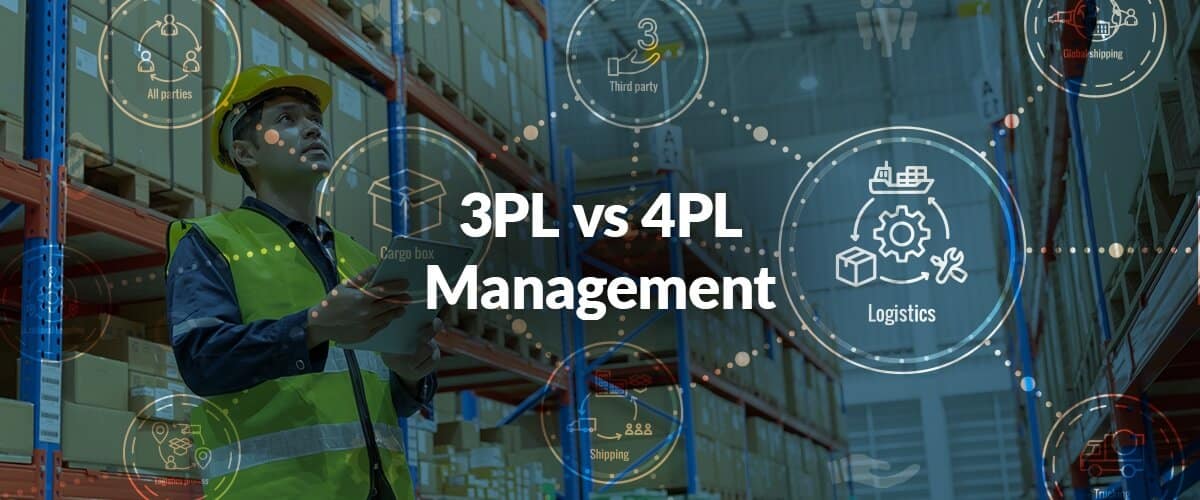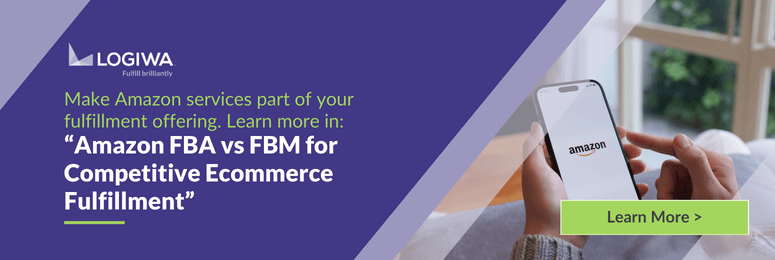In today’s increasingly competitive ecommerce landscape, many operations have turned to the assistance of third-party logistics (3PL) or fourth-party logistics (4PL) providers in order to successfully meet demand, optimize fulfillment, and focus on growing their business. While the services provided by these two entities are similar in some ways, there are key differentiators you should know if you’re going to be choosing between them.
In this blog, we will answer the question ‘what is 3PL and 4PL management’ and discuss their primary differences to help you select the best option for your business.
Key Takeaways
- 3PLs operate warehouse and distribution facilities and assist with fulfillment logistics on behalf of businesses – ensuring efficient inventory management, order processing, and accurate, on-time order shipping.
- 4PLs, also known as “lead logistics providers” (LLPS), take full control over supply chain logistics, overseeing procurement from suppliers, 3PL relationships, transportation needs, technology use, and financial components contributing to a business’s supply chain.
- While 3PLs focus on “end-to-end” fulfillment logistics (or a segment of a business’s supply chain), 4PLs take on “end-to-end” supply chain logistics management.
- Some of the primary differences between 3PLs and 4PLs revolve how big of a role they play in managing a part or all of a business’s supply chain, as well as: their ability to resolve logistical issues, scalability and cost, and the levels of visibility they provide.
- As always, choosing between working with a 3PL or outsourcing your supply chain management to a 4PL comes down to the unique characteristics of your business.
Contents
What is 3PL Management?
Chances are you’re already somewhat familiar with third-party logistics (3PL), since they are more common than 4PLs and have become a standard component to many ecommerce businesses. Here’s a scenario to help define their function:
Imagine you are a growing SMB currently selling items through an ecommerce platform. As your order volume increases, you realize you need more space to store your expanding inventory and resources to expedite day-to-day operations (i.e. processing orders and packaging items to ship). Without an appropriately sized facility, enough staff, or the technology to support complex order fulfillment, you worry you may not be able to meet rising demand.
To maintain order accuracy and on-time delivery dates, you need to outsource your fulfillment logistics. You need a partner capable of storing your products, processing your ecommerce orders, and getting items shipped in a timely fashion.
Third-party logistics (3PL) providers present the perfect partner for this situation. They operate facilities and manage fulfillment logistics on behalf of businesses to ensure demand is met with accurate, on-time order processing. By delegating a portion of logistics to a 3PL, businesses gain access to 3PL’s various assets and a direct ally for optimizing fulfillment results, improving customer satisfaction, and extending the reach of their business.
What is 4PL Management?
At first glance, fourth-party logistics (4PL) may appear to serve the same function as 3PLs. But rather than overseeing day-to-day fulfillment logistics, 4PLs take on the management of your entire supply chain – including the procurement of goods, transportation and freights, and acquiring resources for storing inventory, fulfilling online orders, and executing last-mile delivery. Here’s a scenario to illustrate the function of a 4PL:
Imagine you’re an established brand, wholesaler, or online merchant running a large-scale operation. You have high-volumes of inventory to procure, store, process, and ship in order to meet consumer demand. After some time, you realize your supply chain is struggling to run efficiently, and the complexity of your logistical challenges require additional assistance. Before these circumstances can escalate, you decide your team is not equipped to integrate, manage, and optimize all the moving parts of your supply chain alone. The solution? Find a partner who can.
4PLs, also known as “lead logistics providers” (LLPS), take full control over supply chain logistics to help businesses meet their goals. This includes overseeing the acquisition of goods, 3PL relationships, transportation needs, technology use, and financial components contributing to supply chain success. 4PLs act as the “middleman” between businesses and their supply chain partners, all to optimize a business’s overarching operations.
Unlock a personalized tour of Logiwa IO
Differentiators Between What Is 3PL vs. 4PL Management
While 3PLs accomplish “end-to-end” fulfillment logistics, 4PLs take over complete management of “end-to-end” supply chain logistics. Both oversee logistics, but 3PLs are focused on daily order fulfillment, while 4PLs are focused on all components contributing to a fulfillment network supply chain. Let’s discuss what this difference means through a few key lenses.
Operational Control
If you choose to work with a 3PL, you maintain control over your business and supply chain, while the 3PL assists with tracking orders, managing inventory, packing up items, and shipping out orders to customers. It is a partnership, one where you make business decisions based on the various assets and afforded to you by your chosen 3PL: where you want your inventory to be stored within their fulfillment network, what aspects of their technology you want to use, and what your requirements you have for how they fulfill your orders.
4PLs, in contrast, act as the administrative force behind your supply chain and create a buffer between you and your various partnerships. They take the active role in guiding your supply chain strategy and executing a solution-oriented logistics approach on your behalf. This includes designing your supply chain to meet your goals and captaining its various aspect without you having to get involved: finding the best manufacturers or vendors, freight forwarders, 3PLs, shippers, and technology providers, as well as working with those entities to ensure your supply chain is achieving success.
Ability to Resolve Logistical Issues
It’s easy to resolve issues when you are working with a dependable 3PL because you are in direct contact with them. 3PLs are known for improving fulfillment rates and customer service results due to the hands-on role they have with your inventory management, order processing, and shipping operations. If an issue or an inefficiency is occurring, you can quickly address it with them to get the matter resolved.
4PLs rarely own assets like warehouses or freights themselves. Instead, they keep the various aspects of a supply chain moving by managing the relationships with those supply chain partners. Different vendors, 3PLs, shippers, etc. maintain their own operational systems and standards, which can lead to inconsistencies in fulfillment execution. If a problem arises around customer service or fulfillment accuracy, for example, it can take more time to resolve them.
Scalability and Cost
Both 3PLs and 4PLs provide you with a way to expand your fulfillment networks, grow your business, and manage cost-efficiency. But the variety of facility options you have access to, and the costs you take on, will depend on which you choose.
As previously mentioned, 3PLs are typically asset-owning, meaning they own their own warehouses, fulfillment and distribution centers, proprietary technology, transportation vehicles, etc. On the one hand, this gives your business immediate access to many facilities, geographic reach and resources, leading to efficiency boosts and reduced operational costs. On the other hand, it means you will be limited to what the 3PL has to offer. This makes choosing the right 3PL critically important.
In contrast, 4PLs are non-asset owning. They do not face the same restrictions as a 4PL and will construct your supply chain to include whatever partnerships and assets will benefit your operations most. This makes adding new warehouses and scaling your business easier in a different way. Your 4PL can partner with multiple 3PLs and opt for bundled service options, better manufacturers and vendors, and upgraded fulfillment technologies. The drawback here, of course, is increased costs and varying consistency.
Visibility
Both 3PLs and 4PLs give you access to BI, analytics and reporting tools to provide you with insights into your inventory, ecommerce orders, forecasted demand, shipping data, fulfillment success rates, costs, and more. But there is some nuance behind this similarity.
3PLs offer visibility into a specific segment of your operations. They will be able to show you all the essentials just mentioned, but their focus is often on the day-to-day logistics of your fulfillment operations. The real-time visibility offered by 3PLs is often concentrated on live inventory levels, incoming orders, shipping statuses, and operational KPIs. This is aimed at giving you greater control over your fulfillment operations and boosting efficiency in the short-term.
4PLs offers a more macro-level view of your business. Rather than zeroing in on individual warehouses and order fulfillment results, 4PLs often compile larger amounts of data to measure the efficiency of your supply chain as a whole. As the prime aggregator of all your business data, they focus on insights affecting supply chain optimization, such as the effectiveness of certain partnerships or efficiency of your various strategies. As a result, their visibility supports a more holistic, high-level overview geared towards long-term growth.
Choosing Between a 3PL and 4PL
As always, choosing between working with a 3PL or outsourcing your supply chain management to a 4PL comes down to the unique characteristics of your business. Are you a rapidly growing SMB, or are you an enterprise-level, global operation? Do you want help improving order fulfillment results and customer service, or are you wanting a faster way to adjust your supply chain?
These are important questions to weigh, along with the differences we’ve discussed in this article. Luckily, there are solutions like Logiwa’s WMS and fulfillment platform that aid visibility for both types of logistics management. Our cloud fulfillment solution aids brands, wholesalers, online sellers, 3PLs and 4PLs alike. Learn more at: https://www.logiwa.com/.
FAQs – What is 3PL vs. 4PL Management?
What is 3PL (third-party logistics)?
Third-party logistics (3PL) are providers that operate warehousing and distribution networks, as well as manage fulfillment logistics on behalf of businesses. Brands, wholesalers, and online merchants outsource logistics related to inventory management, order processing, and shipping to 3PLs to ensure they are able to efficiently meet demand, accomplish accurate, on-time order fulfillment, and improve customer service.
What is 4PL (fourth-party logistics)?
4PLs, also known as, lead logistics providers manage a business’s entire supply chain operations. They work on behalf of their clients to create a high-efficiency supply chain and act as the single point of contact between all the parties tied to the supply chain. They procure products from manufacturers or vendors, manage relationships with and between 3PLs, and oversee the efficiency of freight forwarders and shippers, as well as a business’s transportation needs, technology, finances, and more.
How are 3PLs and 4PLs different?
3PLs oversee fulfillment logistics, including inventory management, order processing, and shipping operations. They work directly with their clients and asset-owning in order to optimize day-to-day logistics. 4PLs, which often include 3PLs, take over the management of a business’s entire supply chain. They act as the “middleman” between businesses and all fulfillment partners contributing to their supply chain.






